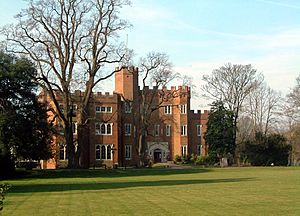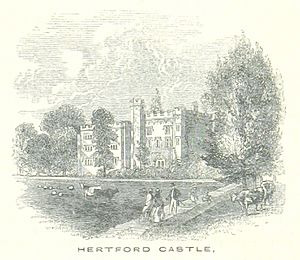Hertford Castle facts for kids
Quick facts for kids Hertford Castle |
|
|---|---|
| Part of Hertfordshire | |
| Hertford, England | |

The 16th to 18th-century façade of Hertford Castle Gatehouse.
|
|
| Coordinates | 51°47′44″N 0°04′48″W / 51.7955°N 0.0800°W |
| Height | Up to 15 metres (49 ft) |
| Site information | |
| Owner | Hertford Town Council |
| Open to the public |
No |
| Condition | Rebuilt |
| Site history | |
| Built | 911: Anglo-Saxon burgh 1066: Motte-and-bailey 1170 - 1174: Rectangular castle 1540s: Royal Tudor Palace 17th - 20th Century: Private residence |
| Built by | Edward the Elder William the Conqueror Henry II Henry VIII William Cecil, 2nd Earl of Salisbury |
| In use | Occupied |
Hertford Castle was a Norman castle built next to the River Lea in Hertford, the main town of Hertfordshire, England. Today, only the gatehouse of the castle remains. This gatehouse is a very important historical building, known as a Grade I listed building.
History of Hertford Castle
Medieval Times
Hertford Castle was first built as a strong fort by Edward the Elder around the year 911. By the time the Normans invaded England in 1066, there was a motte and bailey castle on the site. This type of castle had a large mound (motte) with a tower and a walled courtyard (bailey), all surrounded by a moat (a ditch filled with water).
After the Norman invasion, William the Conqueror gave the castle to Peter de Valognes. Peter was the High Sheriff, a royal official, for Essex and Hertfordshire.
Later, King Henry II was very interested in the castle. Between 1170 and 1174, he had it almost completely rebuilt. New flint walls, drawbridges, and gatehouses were added. The castle was made even stronger during the time of King Richard I. His regent (someone who rules for a king who is too young or away), William Longchamp, oversaw these improvements.
By this time, the castle was controlled by the Crown (the king). This happened after Robert de Valognes died in 1184 without any sons. However, Robert's son-in-law, Robert Fitzwalter, claimed the castle. He took it over and put his own people in charge. Even though King John later removed him, Robert Fitzwalter was eventually made governor of the castle.
In 1216, after a battle, a French army attacked the castle. They surrounded it for a month until the governor, Walter de Godarvil, gave up. However, the country then supported King Henry III, and the French left by 1217. After this, the castle was used less for fighting and more as a home for royalty. In 1299, King Edward I gave it to his second wife, Margaret.
During the time of King Edward II, the castle held its first political prisoners. These were some of the Knights Templar in 1309. Both Edward's wife, Isabella, and their son, Edward III, spent a lot of time at the castle.
During the Hundred Years' War, the castle was used to hold important prisoners, including kings and nobles. These included King David II of Scotland and, in 1359, King John II of France. The next year, the castle was given to Edward III's third son, John of Gaunt. He spent a lot of time there, using it as his main country home when he wasn't fighting abroad. The castle's defenses were repaired and made stronger again during this time.
When John of Gaunt died in 1399, King Richard II took all of John's lands, including Hertford Castle. He then put his new wife, the eight-year-old Princess Isabella, there.
The castle continued to be owned by the royal family. In 1418, King Henry V gave it to his new wife, Princess Katherine of France. They spent much time there together. Henry's son, King Henry VI, spent most of his early childhood at the castle. In 1445, he married Margaret of Anjou and gave her the castle.
However, because of the Wars of the Roses, the crown went to Edward IV. He then gave the castle to his wife, Elizabeth Woodville.
When Richard III became king, he gave the castle to one of his biggest supporters, the Duke of Buckingham. After Richard III lost power, King Henry VII gave the castle to his wife in 1487. Henry himself didn't spend much time at the castle.
His son, King Henry VIII, spent a lot of money changing the castle into a royal palace. He built the gatehouse that still stands today. Later, King Edward VI gave the castle to Princess Mary. When she became queen, the castle was used to imprison Protestant people who were against her religious beliefs. Queen Elizabeth I often visited Hertford.
Modern Times
From the time of King James I, the castle stopped being a royal home and started to fall apart. After King Charles I became king, the castle was given to William Cecil, 2nd Earl of Salisbury. Much of the castle was in ruins because it hadn't been used since Tudor times.
The castle was rented out to Sir William Harrington, who worked to fix the buildings. He then passed his lease to Sir William Cowper. From this time, the Cecil family owned the castle, but they rented it out to many different people over the years. Around 1790, a south wing was added to the gatehouse. The windows of the gatehouse were changed, and a decorative wall (parapet) with brick battlements was added. Around 1800, a new gate and lodge (small house) were built by the Marquess of Downshire.
Between 1805 and 1809, the castle became home to the East India Company College, a school for people who would work for the East India Company. In 1822, a general clinic (dispensary) was set up at the castle by Rev. Thomas Lloyd, who helped with charity work in the town.
In 1911, the Hertford Corporation (the local government) rented the gatehouse of the castle from the Marquess of Salisbury. They used it for their offices. The castle grounds became a public garden for everyone to enjoy. In the 1930s, a north wing was added to the gatehouse. In the late 20th century, Lord Salisbury gave what was left of the castle to the town of Hertford.


